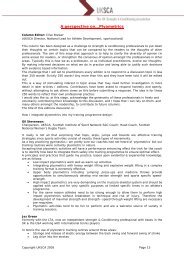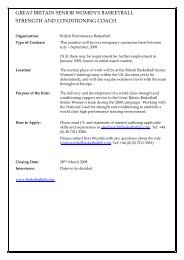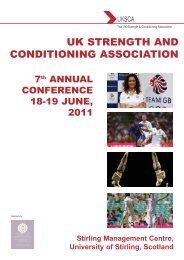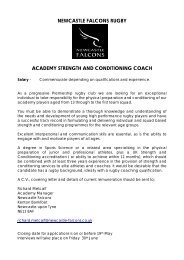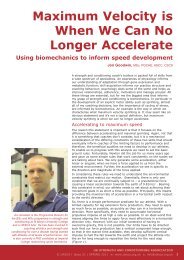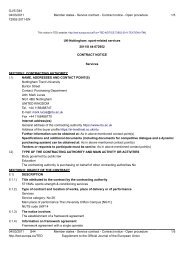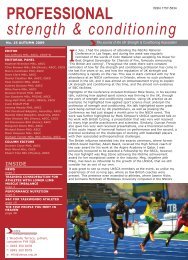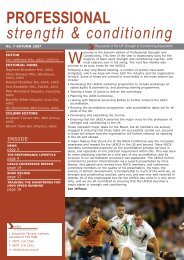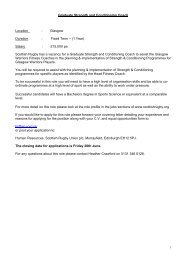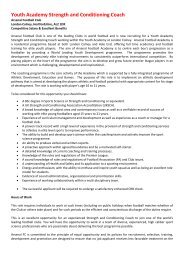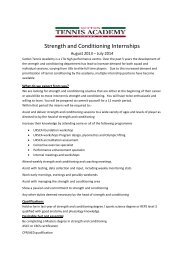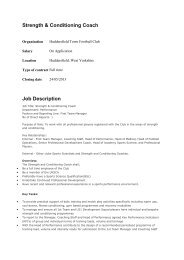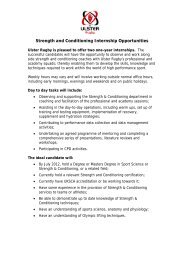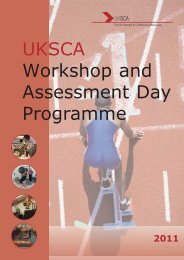uksca news june 2010.qxp
uksca news june 2010.qxp
uksca news june 2010.qxp
Create successful ePaper yourself
Turn your PDF publications into a flip-book with our unique Google optimized e-Paper software.
An approach to the<br />
periodisation of training<br />
during the in-season for<br />
team sports<br />
Nick Chadd, MSc, BSc (Hons), ASCC, CSCS<br />
Nick is a strength and conditioning<br />
practitioner at the English Institute of<br />
Sport in the North West region,<br />
where he is currently Lead Strength<br />
and Conditioning coach for Disability<br />
Swimming. Recent research has<br />
focused on the organisation of<br />
training in team sports.<br />
Summary<br />
A plethora of research has focused on the benefits of structuring pre-season<br />
training. However, there is a scarcity of research focusing on the potential of<br />
in-season training. This article will aim to provide the reader with evidence<br />
based and theoretical based approaches to optimising in-season strength<br />
and conditioning for team sports.<br />
Introduction<br />
Many team sports require different components of physical fitness, often<br />
including speed, strength, power and power endurance, as well as tactical<br />
and technical mastery whilst enduring mental stress and fatigue. 12,36 A<br />
further challenge for team sports is the extended seasons that athletes must<br />
endure, with seasons not uncommonly lasting in excess of 35 weeks in<br />
rugby union and football. 12 A well structured strength and conditioning<br />
programme has been shown to enhance muscle and bone strength, as well<br />
as eliciting improvements in muscular endurance. 13 These adaptations allow<br />
athletes to endure the repeated mechanical stress experienced during<br />
training and competition, and enables athletes to both improve performance<br />
in the mentioned characteristics and also to reduce the risk of injury. 12,24 It is<br />
also worth mentioning that due to financial difficulties in the current<br />
economic climate, it has not been uncommon to see playing squads reduced<br />
in size, causing a higher density of games to be played by the remaining<br />
players, which can reduce the opportunity for player rotation aimed at<br />
minimising cumulative fatigue.<br />
It is clear that these factors may provide a sub optimal environment for<br />
athlete development through the in-season. However, due to the time<br />
constraints of the off and pre season, it may be necessary to explore<br />
different approaches to in-season training, that impact on the continual<br />
development of the team sports athlete. These limitations provide a<br />
challenge for the strength and conditioning practitioner in trying to impact<br />
positively on performance in season. It is therefore the aim of this article to<br />
propose a method of organising training during the in-season.<br />
What is Periodisation?<br />
Periodisation is a form of structuring training to achieve performance results,<br />
and involves dividing the annual training plan into phases and training units<br />
i.e. macrocycles, mesocycles, microcycles. 19,34 Periodisation aims to provide a<br />
method of integrating planning and training by manipulating training<br />
variables in appropriate sequences or combinations, 27 to create a systematic<br />
approach to optimising training. Its aim is to structure training around not<br />
only the annual training plan, but also biological adaptation to environmental<br />
stimuli 34 to create optimal athletic development in the respective sport.<br />
UK STRENGTH AND CONDITIONING ASSOCIATION<br />
© UKSCA | Issue 18 | Summer 2010 w: www.<strong>uksca</strong>.org.uk e: info@<strong>uksca</strong>.org.uk 5



